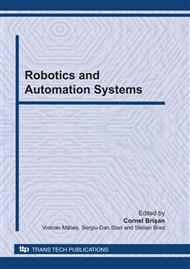[1]
Roland Siegwart and Illah R. Nourbakhsh Introduction to Autonomous Mobile Robots, 2008 The MIT Press ISBN 0-262-19502-X.
DOI: 10.1017/s0263574705221628
Google Scholar
[2]
Mark de Berg, Otfried Cheong, Marc van Kreveld, Mark Overmars, Computational Geometry Algorithms and Applications, 2008 Springer-Verlag ISBN 978-3-540-77973-5.
DOI: 10.1145/369836.571192
Google Scholar
[3]
R. Gonzalez and R. Woods Digital Image Processing Third Edition, 2008 Pearson Pretince Hall ISBN 0-13-505267-9.
Google Scholar
[4]
E.M.M. Clarke, D. Peled and O. Grumberg. Model checking. MIT Press, Boston, MA, USA, (1999).
Google Scholar
[5]
M. Vardi. Branching vs. linear time: Final showdown, Lecture Notes in Computer Science, vol. 2031: 1-22, Springer-Verlag, London, UK, (2001).
DOI: 10.1007/3-540-45319-9_1
Google Scholar
[6]
M. Kloetzer. Symbolic motion planning and control. Ph.D. thesis, Boston University, Boston, MA, USA, (2008).
Google Scholar
[7]
S.G. Loizou and K.J. Kyriakopoulos. Automatic synthesis of multiagent motion tasks based on LTL specifications, IEEE Conference on Decision and Control, vol. 1, pages 153-158, (2004).
DOI: 10.1109/cdc.2004.1428622
Google Scholar
[8]
G.E. Fainekos, H. Kress-Gazit and G.J. Pappas. Hybrid controllers for path planning: a temporal logic approach. IEEE Conference on Decision and Control, pages 4885-4890, Seville, Spain, (2005).
DOI: 10.1109/cdc.2005.1582935
Google Scholar
[9]
M. Kloetzer and C. Belta. A fully automated framework for control of linear systems from temporal logic specifications. IEEE Transactions on Automatic Control, vol. 53(1): 287-297, (2008).
DOI: 10.1109/tac.2007.914952
Google Scholar
[10]
C. Belta, A. Bicchi, M. Egerstedt, E. Frazzoli, E. Klavins, G.J. Pappas. Symbolic planning and control of robot motion. IEEE Robotics and Automation Magazine, special issue on grand challenges for robotics, vol. 14(1): 61-71, (2007).
DOI: 10.1109/mra.2007.339624
Google Scholar
[11]
L. Habets, P. Collins and J. van Schuppen. Reachability and control synthesis for piecewise-affine hybrid systems on simplices. IEEE Transactions on Automatic Control, vol. 51: 938-948, (2006).
DOI: 10.1109/tac.2006.876952
Google Scholar
[12]
J. Desai, J. Ostrowski and V. Kumar. Controlling formations of multiple mobile robots. IEEE Conference on Robotics and Automation, vol. 4, 2864–2869, Leuven, Belgium, (1998).
DOI: 10.1109/robot.1998.680621
Google Scholar
[13]
R. Murphy: Introduction to AI Robotics, The MIT Press, Cambridge, (2000).
Google Scholar
[14]
S. Russell and P. Norvig: Artificial Intelligence. A Modern Approach, Prentice Hall, New Jersey, (1995).
Google Scholar
[15]
J. Xu, F. Hu, X. Han, Realization of Bidirectional A* Algorithm Based on the Hierarchical Thinking During the Process of Path Planning, International Conference on Computer Science and Software Engineering, 2008, pp.415-418.
DOI: 10.1109/csse.2008.1063
Google Scholar


